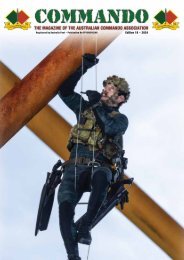Commando News Magazine edition 8 2021
Create successful ePaper yourself
Turn your PDF publications into a flip-book with our unique Google optimized e-Paper software.
John Leopold Howard had taught English, French<br />
and German at St Petersburg University for 20 years.<br />
He fell out with the Soviets after seeing several people<br />
shot dead by the Red Guard and fled to London with<br />
his wife in 1920. He came to Perth in 1927 and lectured<br />
at the University but lost that job when the Depression<br />
hit. Drifting to Melbourne, he pawned all his<br />
belongings and now worked for 25 shillings a week<br />
sustenance. Too poor to afford the tram fare, every day<br />
he walked from North Melbourne to the Shrine in hope<br />
of work. This was a fall from grace typical of the<br />
Depression: a cultured gent from a wealthy family<br />
who’d once ‘supped with Russian nobility’, seen an<br />
empire fall and the terror of revolution.<br />
“Unemployable, a penniless old<br />
man. ‘I am a professor,’ he says, ‘a<br />
professor with a shovel.’ He shrugs his<br />
shoulders. ‘It all seems so stupid…’”<br />
The Herald, 14 December 1933<br />
One gang of relief workers struck it lucky in May<br />
when someone’s pick hit a solid gold Albert chain in<br />
the dirt. They dug up a small fortune in gold jewellery:<br />
a watch for the chain, 25 brooches and pendants, three<br />
silver thimbles. it was thought the cache was somehow<br />
connected to staff at Government House, 50 yards<br />
away. The gang disbanded when the work dried up<br />
and apparently never presented their find to police—<br />
perhaps making them the best-paid of the Shrine relief<br />
workers.<br />
Lifting up the sculptures for the Tympana in June<br />
signalled the end of construction works and in<br />
November the Shrine was duly dedicated in the Royal<br />
presence. The vaunted £250,000 cost of the project<br />
did not include £60,000 paid in sustenance to the<br />
Shrine’s relief workers. Some were still at work on the<br />
landscaping in 1935.<br />
Last July at<br />
the end of a<br />
Shrine guided<br />
tour, Catherine<br />
Smith came for -<br />
ward to tell me<br />
that her grand -<br />
father was one of<br />
the men who had<br />
built the Shrine.<br />
Leo Thomas<br />
Nolan, a 31-yearold<br />
builder from<br />
Malvern, built<br />
the steps. ‘it’s<br />
some thing we<br />
have always been<br />
Leo Nolan and family Leo worked as a<br />
foreman at the Shrine during the 1920s<br />
Image courtesy of the Nolan family<br />
very proud of.’<br />
Leo’s daughter<br />
(Catherine’s<br />
mother) Gwen recalled her dad was a foreman whose<br />
job was to oversee the quality of workmanship on the<br />
stairs. Anyone who visits or works here knows that the<br />
Shrine has a lot of very beautiful stairs. Leo Nolan joins<br />
the very select band of Shrine construction workers<br />
who we know by name. For the rest, the building itself<br />
is their testa ment. Before it was completed, David<br />
Vaughan spoke of the ‘justifiable pride’ of the workers:<br />
Shrine construction site late 1932<br />
SLV (H91.160/396)<br />
“We realised that the men who built<br />
such a memorial would leave behind<br />
them a monument to themselves as<br />
well as to their fighting countrymen…<br />
a structure that will tell the story of part<br />
of this generation till the world ends.”<br />
Peter Luby is a writer and Visitor Experience Officer<br />
at the Shrine of Remembrance.<br />
COMMANDO ~ The <strong>Magazine</strong> of the Australian <strong>Commando</strong> Association ~ Edition 8 I <strong>2021</strong> 41
















